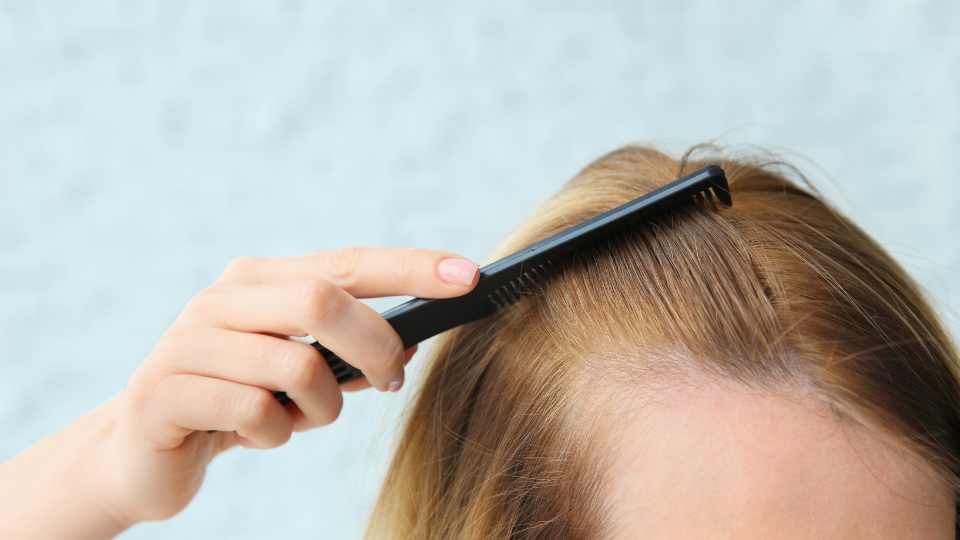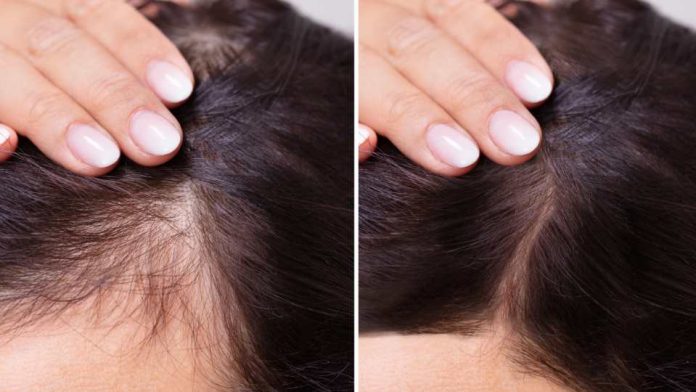Losing hair can be a stressful experience, as it can lower your confidence. Most often, women experiencing severe hair loss with scanty hair growth and visible patches develop depression and remain isolated. If you are also facing hair loss, it is essential to remember that hair loss is a common issue faced by females worldwide. Around 50% of women are affected by hair loss between 40 and 80 years of age[1]. Female pattern baldness is a common hair loss type that affects women of different age groups. It usually develops in women after their menopause. However, it can be rectified with advanced treatments in the haircare world. Read on to know how female pattern baldness differs from that of men, the types of hair transplant procedures available, and their side effects to make a well-informed decision.
What is Female Pattern Baldness?

Female pattern baldness is a hair loss type commonly affecting women and is also known as androgenetic alopecia[2]. The risk of developing this type of hair loss is high during menopause, and the amount of hair fall increases with age. It occurs due to various factors, such as genetic factors, when the parents have a history of severe hair loss. When produced in excess, hormones like androgens cause pattern hair loss in women. Another factor that causes androgenetic alopecia is endocrine dysfunction, which might also trigger high androgen activity to cause hair loss. As you age, the hair-growing phase called anagen gets shorter, which leads to shrinkage of hair follicles, causing thinner hair. This process, known as follicular miniaturization, replaces thicker hair shafts with more delicate strands, referred to as villus.
Symptoms of Female Pattern Baldness
- Breakage or falling hair in huge amounts every day
- Visible thinning hair patches with missing hair in the crown region
- Scalp skin is visible through the hair strands
How Is Female Pattern Baldness Different from Male Pattern Baldness?
Androgenetic alopecia or pattern hair loss is common in both men and women. The recession of hair along the hair parting, which can be either partial or full, is a classic indicator of female pattern baldness. However, the men pattern baldness causes hair to recede in a distinct ‘M’ form with hair thinning along the crown to cause complete or partial baldness[3]. In women, hair thinning occurs all over the scalp, and there is no hair recession along the forehead. And women suffering from androgenetic alopecia don’t face complete baldness.
Psychological and Aesthetic Importance of Hair for Women
From historical times, a woman’s hair has been a representation of beauty and power. Egyptian complex hairstyles and fancy French wigs of the 18th century indicate that women considered their hair a significant medium of identity and self-expression. Every girl would agree that a good hair day will boost their self-esteem and confidence, while a bad hair day can make you insecure. There is an emotional connection between the desire to look best and its influence on how others perceive you.
Your hair’s style, length, or colour is a unique way to express your self-identity. It also creates a sense of belonging within a society, as it defines your social identity and ethnicity. When facing hair loss caused by underlying medical issues, ageing, or depression, can have a significant psychological impact. It can cause loss of identity, depression, and insecurity, so opting for hair transplant procedures is imperative to regain the lost hair caused by female pattern baldness.
Cases When Hair Transplant Is Recommended
Your doctor will recommend a hair transplant procedure if you fulfill any of the following conditions[4]:
- Age / Sex: Generally, a person’s sex or age is not a limiting factor in considering a hair transplant procedure. People aged between 30 years and 70 years are ideal candidates for hair transplant procedures.
- Severe Hair Loss: Males or females experiencing well-defined pattern baldness are ideal candidates for hair transplantation[5]. Women with specific hair loss patterns will also qualify for the hair transplant procedure.
- Healthy Hair Follicles: To qualify for a hair transplantation procedure, it is important to opt for healthy hair at the back and sides of your head. These donor areas should have healthy follicles, essential for grafting and restoration.
- Other Hair Issues: People who are dealing with scalp injuries, scalp scarring, and scalp surgery procedures can also avail of hair transplantation.
Types of Hair Transplant Procedures
There are three types of hair transplant methods: FUT or Follicular Unit Transplantation, FUE or Follicular Unit Extraction, and DHI or Direct Hair Implantation. The significant differences between these hair transplant procedures are the way the extraction of hair follicles is performed in the donor site and the way they are implanted within the receptor site[6].
1. Follicular Unit Transplantation (FUT)
Follicular Unit Transplantation is one of the oldest procedures of hair transplantation, where a thin donor strip is extracted from your scalp surgically[7]. These healthy hair follicles that are extracted are further divided into single units by your dermatologist. It is then inserted in the donor site to encourage hair growth. The implantation of the hair follicles is performed by creating holes or incisions in the reception area using forceps. This FUT procedure will leave a scar where the donor area has been removed.
2. Follicular Unit Extraction (FUE)
Follicular Unit Extraction is a very popular method of hair transplantation, which is performed by making a circular-shaped cut[8]. It removes a group or individual hair follicles from the skin with the help of a punch. This method will leave a tiny open hole on the scalp, which, upon healing, will cause small white scars on the site. When compared to FUT scars, FUE scars are not very visible. Your dermatologist would create small perforated holes in the treatment area to place the extracted hair follicles using forceps[9]. However, it provides zero or less control over the direction, angle, or depth of the hair that regrows.
3. Direct Hair Implantation (DHI)
Direct Hair Implantation is one of the most recent and advanced techniques in the field of hair transplantation[10]. This hair transplantation method is usually performed only by certified and experienced surgeons. During this procedure, the hair follicles are extracted gently one after the other with the help of a tiny extractor with less than 1 mm diameter. The extracted follicles are then implanted in the treatment section directly with a single-use implanting device. In this method, your surgeon has complete control over the hair’s direction, depth, and angle to ensure naturally looking hair.
The hair regrowth is similar to the texture of your natural hair, and you can style it as required. As it is based on the Direct Hair Implantation technique, your hair will have natural density and texture. It is performed using local anaesthesia, and the sessions last around one or two hours based on the amount of extraction of hair follicles. The DHI procedure doesn’t require recovery time and lets you continue your regular activities. It doesn’t leave any scars and has about 90% hair follicle survival rate, making it a convenient choice.
FUT vs FUE vs DHI: Which Hair Transplant Procedures to Choose?
Which hair transplantation technique is best among the three? We’ve got you covered. Considering these aspects of hair transplantation procedures will help you make a practical, well-informed choice.
Surgical Technique Used
In FUT, liner harvesting or a skin strip is removed from the scalp to extract the follicles[11]. The area is then sutured up. In FUE, singular follicles are removed from donor sites like sides and back, which is why the harvesting process is different[12]. The DHI method follows a similar technique to FUE but includes a different implantation stage. It uses a pen-like device to make incisions and insert grafts in problem areas.
Effectiveness
FUE hair transplantation is effective, as it has a hair graft survival rate of around 90%, doesn’t leave any visible scars, and has a quick recovery period. When the donor area has weak follicles and the balding area is enormous, the dermatologist might suggest the FUT method. It will lower the transaction risks involved while extracting on weak donor sites to achieve optimum hair density. If your scalp needs less than 3000 grafts and you don’t want to shave off the recipient site, then the DHI method would be a good choice. With this technique, thousands of grafts can be implanted in the treatment site, offering excellent density compared to the other two methods.
Scarring Rate
FUE and FUT hair transplantation methods will lead to scarring, which would fade off eventually. The slight difference between both is the shape and size of the scar. However, in FUT, the strip removed will cause a linear scar at the backside of the scalp, which may look raised and thick after healing. The small circular holes of FUE leave tiny scars that are not visible, similar to DHI. According to the census results by ISHRS or the International Society of Hair Restoration Surgery[13], over 75% of people preferred FUE. In comparison, 21% opted for FUT, as FUE scars were discreet and healed quickly.
Recovery Time
The DHI and FUE, hair transplant methods have tiny wounds that don’t require stitches. However, as already discussed, the FUT method involves using stitches. FUT procedure will need around 5 weeks of recovery, while FUE consists of a few days.
Even though each method of hair transplantation is unique, it is always safe to discuss the pros and cons of each procedure with your dermatologist before making a choice.
Risks or Potential Side Effects
You might experience any of the following side effects[14] after a hair transplantation procedure:
- Possibility of developing skin infections on the scalp[15]. Development of pus in crusted skin where the harvesting and implantation were performed
- Pain and inflammation at the treatment site
- Itching, numbness, swelling and redness in the scalp
- Loss or sensation with or without slight bleeding in the scalp
Results: What to Expect
- DHI: It assures 100% natural hair growth result, as it offers the surgeon full control over the direction, angle, and depth during follicle placement.
- FUT: Unnatural hair growth, as it doesn’t offer good control over the direction, depth, or angle during follicle placement.
- FUE: It also results in unnatural growth, as the surgeon has zero control over the direction, angle, and depth when placing hair follicles on the scalp.
Alternatives to Hair Transplantation for Women
For those of you trying to avoid hair transplantation surgery, try the following alternatives –
- Use medications like minoxidil and finasteride
- Hair treatments like prescription strength steroid shots, scalp micro pigmentation, Platelet-rich plasma or PRP treatment
- Using hair replacement options like wigs
Summing Up
Having voluminous, thick, and shiny hair is a dream of many women facing low to high levels of hair loss. But, female pattern baldness, which develops due to an underlying medical condition, might require you to opt for a hair transplant procedure. If you are thinking of choosing one of these highly popular hair transplant procedures, visit Kolors Healthcare, the reputed skin and haircare clinic. Their team of dermatologists will guide you toward the best hair transplant procedure based on the extent of your female pattern baldness.
References
- Department of Dermatology, St Vincent’s Hospital, Fitzroy, Victoria, Australia – https://www.ncbi.nlm.nih.gov/pmc/articles/PMC2684510/
- Division of Dermatology, Duke University Medical Center. Durham, North Carolina – https://www.sciencedirect.com
- Department of Dermatology and Skin Science, University of British Columbia, 835 West 10th Avenue, Vancouver, BC, Canada – https://pubmed.ncbi.nlm.nih.gov/23159182/
- International Society Hair Restoration Surgery, New York, New York, United States – https://www.ncbi.nlm.nih.gov/pmc/articles/PMC8719975/
- Department of Dermatology, School of Medicine, Hospital Universitario Virgen Macarena, Seville, Spain – https://pubmed.ncbi.nlm.nih.gov/19341939/
- Mediteknia Dermatology and Hair Transplant Clinic, Universidad Fernando Pessoa Canarias, Gran Canaria, Spain – https://pubmed.ncbi.nlm.nih.gov/33905785/
- Rousso Facial Plastic Surgery Clinic, Birmingham, Alabama 35223, USA – https://pubmed.ncbi.nlm.nih.gov/19034815/
- Centre for Excellence in Esthetics and Dentistry, Nandan Apartment, C-72 Sarojini Marg, C-Scheme, Jaipur, Rajasthan – https://pubmed.ncbi.nlm.nih.gov/31624428/
- Consultant Dermatologist and Hair Transplant Surgeon, Dr Amit Kerure Skin Clinic, Sector 9, Vashi, Navi Mumbai, India – https://pubmed.ncbi.nlm.nih.gov/34211903/
- Department of Dermatology and Venereology, National Skin Clinic, Dehradun, Uttarakhand, India. – https://pubmed.ncbi.nlm.nih.gov/24023433/
- Department of Cosmetic and Hair Transplant, Enhance Clinics, Kolkata, West Bengal, India. – https://pubmed.ncbi.nlm.nih.gov/34984084/
- Feinberg School of Medicine, Northwestern University, Chicago, IL, USA – https://pubmed.ncbi.nlm.nih.gov/36040012/
- International Society of Hair Restoration Surgery, Chicago, USA – https://ishrs.org
- Dr. Amit Kerure Skin Clinic, Navi Mumbai, India – https://www.ncbi.nlm.nih.gov/pmc/articles/PMC6371733/
- Poswal’s Clinic, New-Delhi, India – https://pubmed.ncbi.nlm.nih.gov/22121268/









